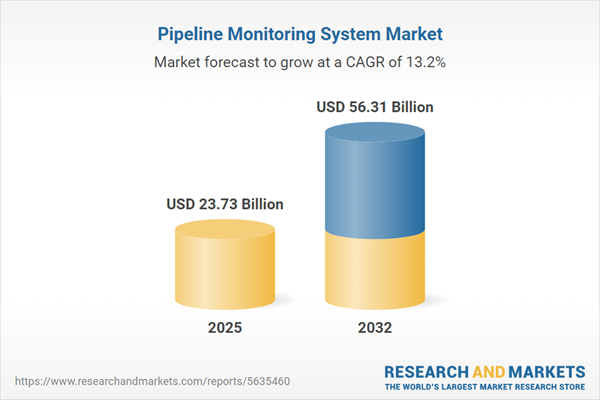Speak directly to the analyst to clarify any post sales queries you may have.
The pipeline monitoring system market is experiencing robust growth, driven by increasing global demand for operational safety, infrastructure integrity, and regulatory compliance across the energy, chemicals, and utilities sectors. Senior stakeholders face shifting challenges and emerging opportunities as advanced monitoring solutions transform risk management and performance optimization.
Market Snapshot: Pipeline Monitoring System Market Growth and Outlook
The pipeline monitoring system market grew from USD 20.92 billion in 2024 to USD 23.73 billion in 2025, setting a foundation for ongoing expansion at a CAGR of 13.17%. Projections indicate the market will reach USD 56.31 billion by 2032, reflecting rising investments in infrastructure digitalization and real-time monitoring solutions for critical pipelines worldwide.
Scope & Segmentation: Core Coverage of Pipeline Monitoring Systems
- Technology: Including acoustic, fiber optic, pressure, and ultrasonic approaches, supporting both legacy and new pipeline projects.
- Application: Solutions span corrosion monitoring, flow measurement, integrity assessment, and leak detection for risk mitigation and asset longevity.
- Deployment Mode: Both cloud-based and on-premise systems, adaptable for scalable data management and security considerations.
- Pipeline Type: Applicable to chemical, gas, oil, and water pipelines, addressing sector-specific monitoring needs.
- End User: Widely adopted by municipalities, oil & gas companies, petrochemical operations, and utility providers.
- Service Type: Encompasses consulting, installation, maintenance, and training to support lifecycle management.
- Region: Analysis covers Americas (United States, Canada, Mexico, Brazil, Argentina, Chile, Colombia, Peru), Europe (UK, Germany, France, Russia, Italy, Spain, Netherlands, Sweden, Poland, Switzerland), Middle East (UAE, Saudi Arabia, Qatar, Turkey, Israel), Africa (South Africa, Nigeria, Egypt, Kenya), and Asia-Pacific (China, India, Japan, Australia, South Korea, Indonesia, Thailand, Malaysia, Singapore, Taiwan).
- Companies: Key players include ABB Ltd., Siemens AG, Schneider Electric SE, Emerson Electric Co., Honeywell International Inc., General Electric Company, Yokogawa Electric Corporation, Baker Hughes Company, Schlumberger Limited, TechnipFMC plc.
Key Takeaways for Strategic Decision-Makers
- Advanced pipeline monitoring systems empower operators to detect anomalies, such as leaks and corrosion, in real time while enabling predictive maintenance and minimizing unplanned downtime.
- The convergence of acoustic, fiber optic, and ultrasonic diagnostics with AI-powered data analytics supports proactive risk management and streamlines maintenance workflows.
- Collaborative frameworks between service providers, technology vendors, and end users facilitate tailored monitoring solutions, improving system interoperability and lifecycle performance.
- Regulatory developments and environmental mandates are accelerating the adoption of sophisticated monitoring architectures and driving continuous upgrades across global regions.
- Competitive advantages arise from investment in machine learning, autonomous inspection tools, and partnerships that extend technological and service capabilities.
Tariff Impact: Effects on Supply Chain and Market Structure in 2025
New tariffs enacted in the United States in 2025 have increased costs for imported monitoring components, prompting a shift toward local sourcing and accelerated domestic manufacturing. Operators are reevaluating procurement strategies, emphasizing total cost of ownership, and adopting service-based models to offset hardware inflation. Domestic players are leveraging these dynamics to innovate, strengthening regional supply chains and altering competitive positioning in the global market.
Methodology & Data Sources
This report is based on a dual approach using primary research—comprising interviews with end users, technology providers, and regulatory experts—and extensive secondary analysis of technical publications and industry reports. Quantitative surveys and expert roundtables were employed to strengthen interpretations and validate emerging patterns. Analytical frameworks, including SWOT and PESTLE, provide structured competitive and regulatory insights.
Why This Report Matters
- Equips executives and operations leaders with a clear perspective on technology adoption, emerging risk factors, and best practices for pipeline integrity management.
- Informs capital allocation and strategic planning by mapping market forces, regional differences, and supplier landscapes critical to business outcomes.
- Enables procurement and technical teams to identify the most effective monitoring approaches and deployment models for organizational requirements.
Conclusion
The pipeline monitoring system market is advancing rapidly as digital and regulatory drivers reshape industry fundamentals. Decision-makers equipped with comprehensive insights are positioned to drive operational excellence and resilience across complex pipeline networks.
Additional Product Information:
- Purchase of this report includes 1 year online access with quarterly updates.
- This report can be updated on request. Please contact our Customer Experience team using the Ask a Question widget on our website.
Table of Contents
3. Executive Summary
4. Market Overview
7. Cumulative Impact of Artificial Intelligence 2025
Companies Mentioned
The companies profiled in this Pipeline Monitoring System market report include:- ABB Ltd.
- Siemens AG
- Schneider Electric SE
- Emerson Electric Co.
- Honeywell International Inc.
- General Electric Company
- Yokogawa Electric Corporation
- Baker Hughes Company
- Schlumberger Limited
- TechnipFMC plc
Table Information
| Report Attribute | Details |
|---|---|
| No. of Pages | 193 |
| Published | November 2025 |
| Forecast Period | 2025 - 2032 |
| Estimated Market Value ( USD | $ 23.73 Billion |
| Forecasted Market Value ( USD | $ 56.31 Billion |
| Compound Annual Growth Rate | 13.1% |
| Regions Covered | Global |
| No. of Companies Mentioned | 11 |









